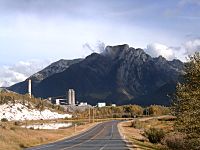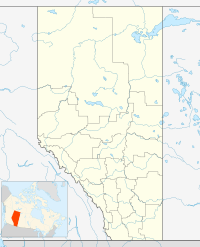Exshaw facts for kids
Quick facts for kids
Exshaw
|
|
|---|---|
|
Hamlet
|
|

Heart Mountain and the Cement Plant at Exshaw. Community is east (left) of the plant.
|
|
| Country | Canada |
| Province | Alberta |
| Region | Alberta's Rockies |
| Census division | 15 |
| Municipal district | M.D. of Bighorn No. 8 |
| Government | |
| • Type | unincorporated |
| Area
(2021)
|
|
| • Land | 1.55 km2 (0.60 sq mi) |
| Population
(2021)
|
|
| • Total | 449 |
| • Density | 289.3/km2 (749/sq mi) |
| Time zone | UTC−7 (MST) |
| • Summer (DST) | UTC−6 (MDT) |
| Area code(s) | 403, 587, 825 |
Exshaw is a small community, called a hamlet, located in Alberta, Canada. It is part of the Municipal District (MD) of Bighorn No. 8.
Exshaw is about 90 kilometers (56 miles) west of downtown Calgary. It is also about 15 kilometers (9 miles) east of Canmore. The hamlet sits in the Bow River valley, just north of the river itself. This area is very scenic, surrounded by mountains. Exshaw was once located within what is now Banff National Park. The original entrance to the park used to be very close to Exshaw.
Contents
History of Exshaw
How Exshaw Got Its Name
Exshaw was named after E. William Exshaw. He was the son-in-law of Sir Sanford Fleming, a very important person in Canadian history. William Exshaw was also a famous sailor. He won a gold medal in sailing at the 1900 Summer Olympics in Paris! He visited the community in 1908.
Early Industries
In the early 1900s, Exshaw became an important industrial area. A large cement plant was built here. Robert D. Hassan, an American engineer, helped build the first cement mill in 1906. This plant was for the Western Canada Cement and Coal Company.
Another company, Loders Lime, also started operating nearby. They took over existing lime kilns. A new, bigger plant was finished by 1908. A mountain peak above Exshaw is even named after Edwin Loder, who started the company. The Loder name is still connected to the area today.
Local Businesses and People
Over the years, other businesses grew in Exshaw. Roy Zeller and his wife Lucille opened a garage around 1926. Lucille also ran a service station and tea room nearby during the summers. They were important members of the community for many years.
Geography of Exshaw
Nearby Communities and Features
East of Exshaw, you'll find smaller communities. These include Kananaskis, which has a lime plant, and Seebe, which used to have a power dam. Seebe is now closed but might be redeveloped for homes in the future. There are also dude ranches in the area. Brewster's Kananaskis Ranch & Golf Course is a notable example. It has been owned by the Brewster family since the 1880s.
South of Exshaw, across the Bow River, is the hamlet of Lac des Arcs. However, there is no bridge directly connecting the two communities.
Mountains and Creeks
Exshaw is surrounded by mountains. To the north is the smaller Exshaw Mountain, which is also known as Cougar Mountain. South of Exshaw, across from Lac des Arcs, is Heart Mountain. This mountain is popular for hiking and is sometimes used for weddings because of its heart shape.
A creek called Exshaw Creek runs through the hamlet. It is also known as Canyon Creek. In 1958, scientists found a new type of ancient clam, called Megalodon banffensis, in a cliff along Exshaw Creek.
The eastern part of Exshaw is on the flood plain of Jura Creek. This creek is famous for its interesting rock formations. Geologists have studied the rocks here to learn about the Earth's history.
About 3 kilometers (2 miles) west of Exshaw is Grotto Creek. This creek has ancient rock paintings, called pictographs. One image might be a "fluteplayer" from the Hopi tradition.
Wildlife in the Area
Even with the industries, the area around Exshaw is known for its wildlife. Long ago, in 1800, explorer David Thompson and Duncan MacGillivray saw a bighorn sheep near Exshaw. This was one of the first times these animals were recorded by Europeans in the Canadian Rockies. A mountain to the west of Heart Mountain is named Mount MacGillivray, in honor of Duncan MacGillivray.
Population of Exshaw
|
||||||||||||||||||||||||||||||||||||||||||||||||||||||||||||
The population of Exshaw has changed over the years. In the 2021 Census, 449 people lived in Exshaw. This was an increase from 412 people in 2016. The community has a land area of 1.55 square kilometers (0.60 square miles). This means about 289 people live in each square kilometer.
Economy of Exshaw
The main industry in Exshaw is the cement plant. It is now owned by Lafarge North America. The plant uses limestone, which is dug out from the mountain north of the plant.
Other important plants and quarries are also in the area. These include Baymag's plant, which makes magnesium oxide. This plant uses special technology to save energy. There is also Graymont Inc's plant, which produces lime and limestone products. Baymag celebrated its 40th anniversary in 2022. It had also reached a goal of producing 150,000 metric tons of magnesium oxide per year.
Administration of Exshaw
Exshaw is the largest hamlet in the M.D. of Bighorn No. 8. This municipal district also includes other hamlets like Benchlands, Dead Man's Flats, Harvie Heights, and Lac des Arcs. It also covers rural ranchland west of Cochrane. The main office for the M.D. of Bighorn No. 8 is located right in Exshaw.


